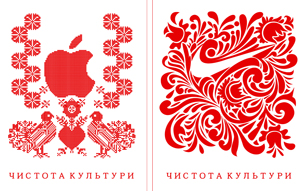“4th Block” makes ecology into a modern art format
Oleh VEKLENKO: After Chornobyl, ecological thinking should be embedded in Ukrainians’ genes
The artistic poster, one of the most effective means of visual propaganda, has been used for more than 20 years by the Association of Graphic Designers “4th Block” to attract the global community’s attention to the most urgent environmental problems. Since 1991 International triennial exhibits have been attracting more and more concerned artists from all over the world, thus becoming a sort of an art forum for environmental protection. According to experts, this project has long made environmental issues into an indispensable format of poster art.
Early in May the 8th International Triennial Eco-Poster Exhibit “4th Block” (previously announced in The Day’s issue No.26 of April 24, 2012) closed in Kyiv. For 10 days the residents and guests of the capital could visit the International Eco-Poster Exhibit-Competition, International Cultural-Show Poster Exhibit-Competition, International Exhibit of Posters Dedicated to the Chornobyl Catastrophe, and the Exhibit of Works by the International Jury Members. Overall, during the exhibit days visitors could see more than 1,000 best eco-posters, handpicked practically worldwide (to select particularly valuable works for the exposition, the masterminds had looked through more than 5,000 posters by 400 authors from 37 countries).
Interestingly, this was the first time that the triennial had been held in Ukraine’s capital. Before that, the major exposition of Ukrainian posters had been only displayed in Kharkiv and abroad (in Denmark, Great Britain, Turkey, Switzerland, Poland, Belarus, Germany, the US, and Russia).
“That the major part of the exhibit was held in Ukraine’s capital this time around pleases us immensely. Also, it is an experiment of sorts,” admitted president of the triennial exhibit project “4th Block” Oleh VEKLENKO, professor at the department of graphic design of Kharkiv State Academy of Design and Arts, after the exhibit was opened. “Strangely enough, our expositions had had more invitations from Europe, as if environmental issues were more urgent there, while there had not been a single invitation from the Ukrainian capital. Renowned worldwide, we had long been waiting for an opportunity to make our existence known in Kyiv.”
The international jury, led by professor Lex Drewinski (Germany), awarded the first prize in the nomination “26. The World since Chornobyl and Fukushima” to Majid Abbasi (Iran) for his 25x25 poster Chornobyl’s 25th Anniversary. The second prize went to Luba Lukova (USA) for her 25x25 poster Chornobyl, Fukushima, and the third, to Igor Gurovich (Russia) for his 25x25 poster 25 years since Chornobyl.
Eco Poster nomination was won by Agnieszka Ziemiszewska-Majik (Poland) with her poster Don’t Cry, Save Water. The second prize was awarded to Anton Stohov (Ukraine) for Global Warming. In the nomination “Eco-Culture” the winner is Olena Fomina (Ukraine) with her series “The Purity of Culture,” while Vladimir Chaika (Russia) is second, with the poster Nature, Our Home. Curiously enough, the range of themes the posters embrace indicate that people worldwide are worried by the same environmental problems. Out of more than 5,000 works, sent to the competition, most were dedicated to the themes of man and environment. Next came air pollution, anti-nuclear themes, and the lack of ecological culture.
“First and foremost, the jury evaluated the solution of the posters and the execution techniques. It is hard to give an objective comment on the level of the works, because being a member of the jury I am always quite critical,” says Lex DREWINSKI, president of the international jury. “Most works display originality of concept. At the same time, there were a lot of posters with hackneyed ideas and imagery, which I had seen some good 10 years before. Hippyish poster images, like a tree stump or a drop of water against the background of a field, are not really interesting today. We need something original and stunning. Perhaps, this is my subjective vision.”
Besides a jury of designers, the posters exhibited at the 8th Triennial were for the first time judged by experts on ecology as well.
“There are lots of talented designers worldwide, who make very good posters. But visually perfect in terms of design, their works could sometimes be superficial in terms of content,” believes Serhii MYRNY, president of the ecological jury. “The ecologists’ mission at this exhibit was to evaluate the works not only as pieces of art, by criteria of design and graphic art, but also from the perspective of contemporary science and the scope of the most urgent problems.”
Summarizing the 8th International Triennial Eco-Poster Exhibit “4th Block,” Veklenko emphasized on the low level of Ukrainians’ ecological mentality.
“We have experienced the Chornobyl disaster. The self-preservation instinct ought to be embedded into Ukrainians’ genes. However, people have learned no lessons. They virtually lack ecological thinking,” said he. “Meanwhile, these posters urge people to think about the environment and themselves. We want to remind people what they breathe, eat, and drink.”
According to Veklenko, during those 10 days not a single public officer or politician visited the exhibit, although invitations had been sent out. Today the political elites are merely uninterested in environmental problems or the possibility of bringing them into the focus of attention by means of visual art.
Having closed the 8th triennial eco poster exhibit in Kyiv, “4th Block” is now looking for an opportunity to display the best works on citylights and billboards nationwide for free, as social advertisement.
Photo replicas courtesy of the Association of Graphic Designers “4th Block”






